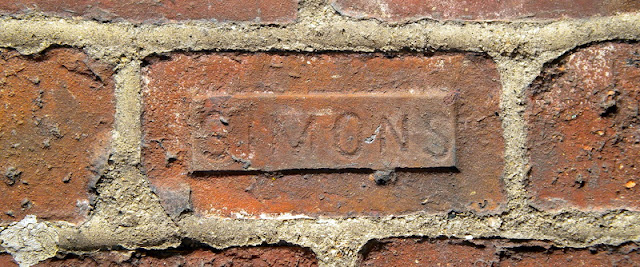I like to explore old maps of Los Angeles and its environs. And when I discover something I'd never heard of before, I'll often get in my time machine (OK, my car) and drive into the future of that map. Such it was when I saw an old map of the area that's now Montebello and the City of Commerce and I noticed a train stop and what looked like a town called Simons. If you ever drive through the area on I-5, it's north of the freeway and north of Telegraph Road, just a bit east of Garfield. There's a Home Depot close by that's pretty close to what was once called Simons.
It was a huge brick manufacturing company, but even more interesting was what I learned about how the owners created a self-contained little city for the employees --- almost all of whom had come north from Mexico to work there, live there, dine there, attend church there, go to school there and even watch movies in the theater there.
When I drove to the area, there was practically nothing left. The school that you'll hear about in the video below is still there, but not the original buildings. What was once a self-contained community is now one of those typical industrial zones with look-alike buildings. I found a few houses that may have been there to house employees. I'll have to do some public records searches to learn more.
Now, whenever I see building or sidewalks made of brick, I look for the distinctive "Simons" bricks. I first found one as part of the steps in front of Shakey's in Burbank. Then I discovered that my neighbors, Jan and Henry, had a couple of Simons bricks on their walkway. Most recently, I found Simons bricks adorning the front walkway in front of my friend Pat Hall's house in Hacienda Heights. OK, I'm hooked on the story of the Simons Brick Factory, better known as Simons Brick Company No. 3.
Today, I was pleased to find a wonderful video made by people who really know how to do the perfect oral history interviews. And they're pretty good at production, as well. I invite you to enjoy it.
And in case you didn't read the full description that goes along with it, I'm including it here:
An interview with Rosa Lemus Carlos who grew up at Simons Brick Company No.3 in Montebello, California.
Her father was a decades-long employee there. Simons Brick Company, established in the Los Angeles area before the turn of the last century, grew to become the biggest brick producer in the world, and to make the millions of bricks that were used to build much of Los Angeles, San Francisco and cities throughout the nation.
Simons imported thousands of Mexican workers and their families to Los Angeles in order to work and live at their 300 acre facility. Simons was almost literally a Mexican town, where generations of Spanish-speaking workers and their families were housed, worked, went to school, worshiped and shopped - and where they died. The work of making bricks was back-breaking and pay was low. But as Rosa Carlos's interview shows, their lives there (and that of their families) were centered around far more than just grueling work: Simons families' cultural and social life was multi-layered, multi-faceted and enriching in its own way.
The Simons Brick Company went bankrupt in the 1950s and closed after more than sixty years of existence, due to changing construction methods causing brick sales to decline drastically. The shanty homes of the workers and their families were condemned and demolished, along with the entire brick yard. Hundreds of Mexican residents saw their homes torn down and the debris set afire, but their memories of their lives at Simons lived on.
Rosa's interview excerpt, from the epic documentary film "Whitewashed Adobe: The Rise of Los Angeles" is very moving and enlightening.
See more at http://www.whitewashedadobe.com






